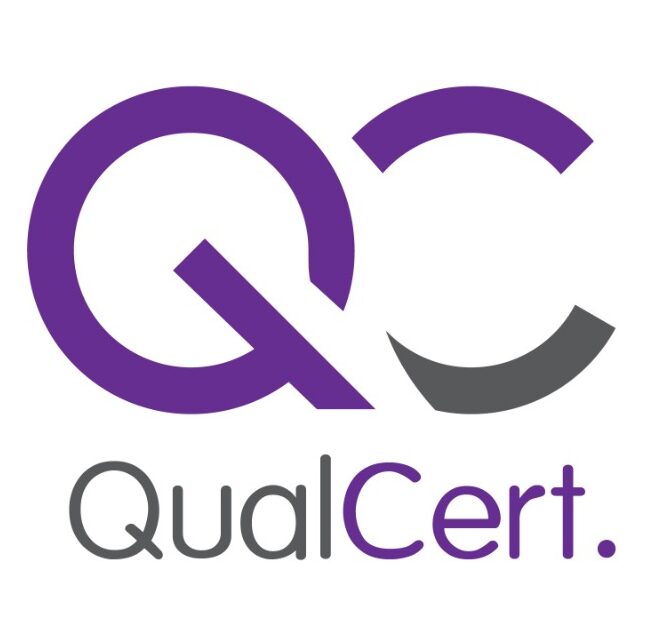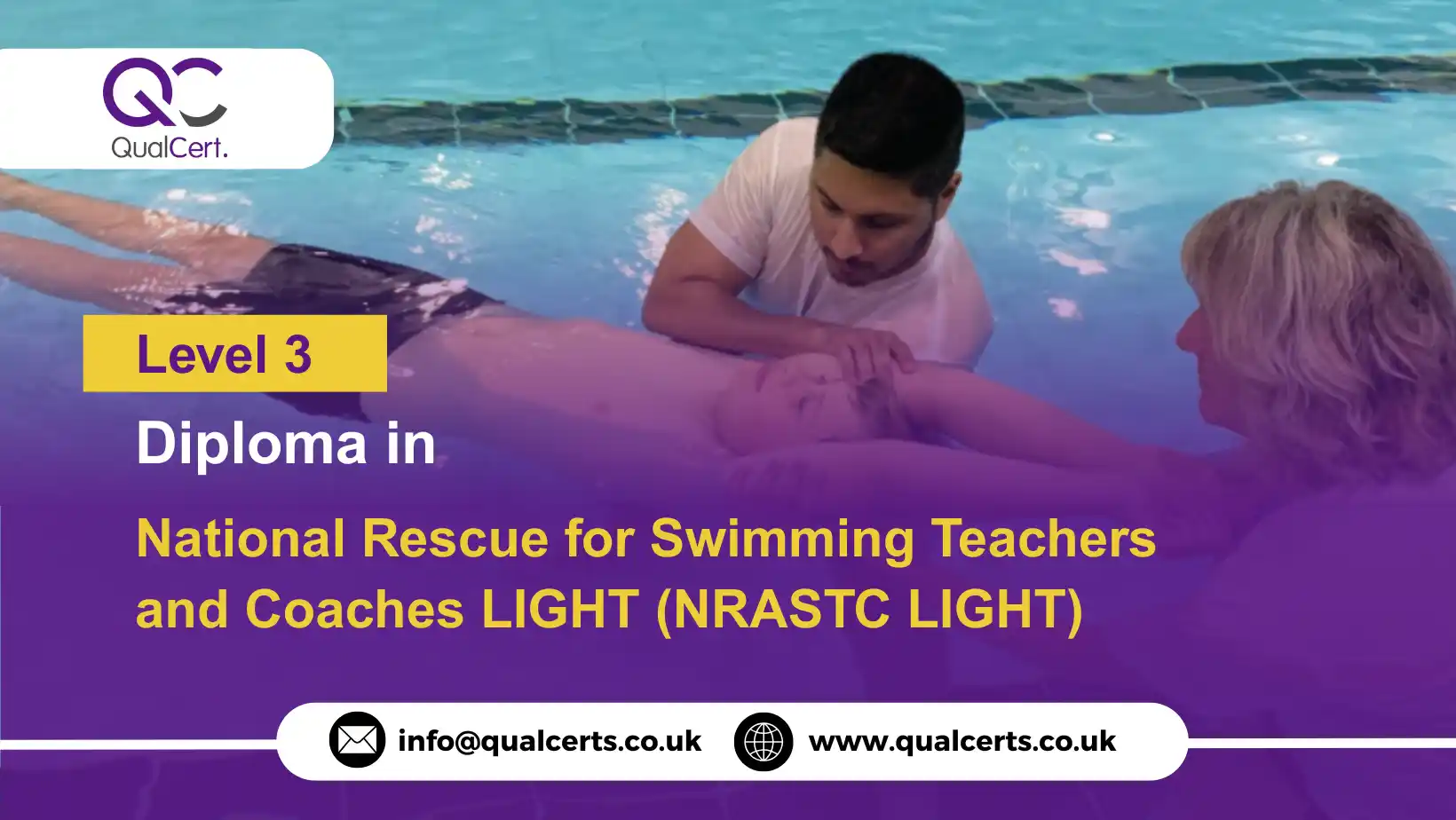The NRASTC LIGHT qualification has been developed to provide swimming teachers and coaches with the skills to respond swiftly and effectively in the event of an emergency, specifically in lower-risk pool settings. The course focuses on practical rescue techniques, casualty management, and understanding safety procedures, all while recognising that the primary responsibility for surveillance and full-scale emergency response lies with the on-duty lifeguard.
The QualCert Level 3 NRASTC LIGHT Diploma is delivered by approved centres and combines both practical and theoretical components. Training is typically delivered over a short period, with assessment through observed practical performance and written knowledge checks.
The QualCert Level 3 Diploma in National Rescue for Swimming Teachers and Coaches LIGHT (NRASTC LIGHT) is the perfect choice for swimming professionals teaching in supervised, low-risk environments. It ensures instructors are equipped with the necessary rescue skills to act effectively during emergencies while remaining focused on their core teaching role. With this qualification, swimming teachers can confidently support a culture of safety in and around the pool.
Course Contents of QualCert Level 3 Diploma in National Rescue for Swimming Teachers and Coaches LIGHT (NRASTC LIGHT):
The QualCert Level 3 Diploma in National Rescue for Swimming Teachers and Coaches (NRASTC), offers 60 Credits, requiring a Total Qualification Time (TQT) of 300 hours, including 210 Guided Learning Hours (GLH).
| Unit Ref# | Unit Title | Credit | GLH | TQT |
| QC26008-1 | Foundations of Rescue for Swimming Instructors in Low-Risk Environments | 10 | 35 | 50 |
| QC26008-2 | Rescue Techniques in Supervised and Shallow Water Pools | 10 | 35 | 50 |
| QC26008-3 | Basic Life Support and Casualty Management for Teaching Professionals | 10 | 35 | 50 |
| QC26008-4 | Risk Awareness and Safety Protocols in Swim Instruction Settings | 10 | 35 | 50 |
| QC26008-5 | Communication and Cooperation in Shared-Safety Pool Environments | 10 | 35 | 50 |
| QC26008-6 | Legal, Ethical and Professional Conduct for Swimming Teachers | 10 | 35 | 50 |
Entry Requirements for the QualCert Level 3 Diploma in National Rescue for Swimming Teachers and Coaches LIGHT (NRASTC LIGHT):
To enroll in the QualCert Level 3 Diploma in National Rescue for Swimming Teachers and Coaches LIGHT (NRASTC LIGHT), following are requirement:
Minimum Age
- Learners must be at least 16 years of age at the time of enrolment. This ensures an appropriate level of personal responsibility and maturity for engaging with the practical and theoretical aspects of aquatic rescue.
Educational Background
- A basic standard of education is recommended, ideally a Level 2 qualification (such as GCSEs or equivalent).
- While formal education is not a strict requirement, candidates should be capable of understanding safety concepts and written instructions relevant to the swimming environment.
Work Experience (Recommended)
- This qualification is designed for individuals who teach or assist in swimming instruction in low-risk, lifeguard-supervised environments.
- While previous experience in swimming teaching or coaching is preferred, it is not mandatory.
- Candidates without prior rescue experience should have a strong understanding of water safety principles or be under the supervision of a qualified lifeguard.
Language Proficiency
- Learners must have a suitable level of English language proficiency to participate fully in training, assessments, and safety communications.
- A minimum proficiency equivalent to CEFR Level B1 or an IELTS score of 5.0 is recommended.
- Learners should be able to read safety information, follow verbal instructions, and communicate clearly in emergency situations.
Learning Outcomes of QualCert Level 3 Diploma in National Rescue for Swimming Teachers and Coaches LIGHT (NRASTC LIGHT):
Foundations of Rescue for Swimming Instructors in Low-Risk Environments
- Understand the scope and limitations of rescue responsibilities in lifeguard-supervised settings
- Recognise common types of incidents that may occur during swimming lessons
- Explain the importance of acting within the boundaries of training and policy
- Identify the key roles of the instructor during an emergency situation
Rescue Techniques in Supervised and Shallow Water Pools
- Demonstrate safe and appropriate rescue techniques for shallow water emergencies
- Apply basic towing and recovery methods suitable for non-lifeguard instructors
- Assist the lifeguard or emergency responder during incidents without compromising safety
- Use available equipment correctly and confidently within the instructor’s role
Basic Life Support and Casualty Management for Teaching Professionals
- Perform essential life support techniques including CPR and rescue breathing
- Manage a casualty until the arrival of professional medical or lifeguard assistance
- Identify and respond to signs of drowning, shock, or other medical emergencies
- Apply safe handling methods to protect both the casualty and responder
Risk Awareness and Safety Protocols in Swim Instruction Settings
- Identify common hazards in swimming teaching environments
- Conduct visual checks and basic risk assessments prior to lessons
- Follow established safety procedures and local emergency action plans
- Promote safety awareness among participants and staff
Communication and Cooperation in Shared-Safety Pool Environments
- Communicate clearly and effectively during an emergency scenario
- Understand the importance of working alongside lifeguards and facility staff
- Respond to verbal instructions promptly and relay accurate information in emergencies
- Contribute to a cooperative and safety-focused team culture
Legal, Ethical and Professional Conduct for Swimming Teachers
- Understand the legal obligations and duty of care associated with swim instruction
- Follow ethical guidelines when dealing with participants, including safeguarding responsibilities
- Maintain professional behaviour and appropriate boundaries at all times
- Recognise the importance of accurate reporting and record-keeping after an incident
The Level 3 Diploma in National Rescue for Swimming Teachers and Coaches LIGHT (NRASTC LIGHT) is designed for individuals who deliver swimming lessons or aquatic activities in low-risk, lifeguard-supervised environments. It is particularly suited to those who need essential rescue skills without requiring full lifeguard certification.
This course is ideal for:
- Swimming teachers and instructors working in shallow or controlled pool environments
- Coaches delivering swimming sessions in facilities where a qualified lifeguard is present
- Assistant swim teachers supporting lead instructors in low-risk aquatic settings
- Professionals seeking a recognised safety qualification to meet employer or regulatory requirements
- Individuals looking to enhance their emergency readiness within the scope of their teaching role
This diploma provides swimming professionals with the confidence and competence to act appropriately during an emergency, while staying within the boundaries of their responsibility in supervised environments. It is a practical, efficient alternative to full lifeguard training for those whose roles do not require it.

